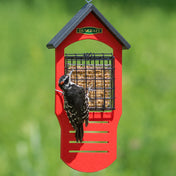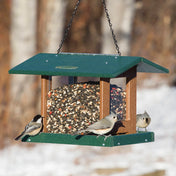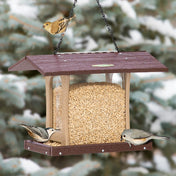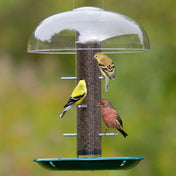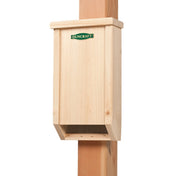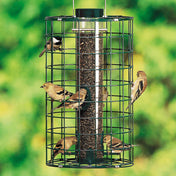Every fall, millions of birds take to the skies, embarking on a journey that can span hundreds—even thousands—of miles. For many species, your backyard can serve as an important rest stop along the way. By making a few thoughtful choices now, you can give migrating birds the fuel and shelter they need to travel safely.

Here’s how you can prepare your yard for fall migration season.
1. Offer High-Energy Foods
Migrating birds need calorie-dense fuel to sustain their long flights. Think of it as stocking up on road trip snacks!
- Black oil sunflower seed is a favorite for many species and delivers quick, reliable energy.
- Suet and suet blends provide high-fat nutrition that’s especially important during colder nights.
- Peanuts and tree nuts are irresistible to woodpeckers, jays, and chickadees.
- Nectar feeders help late-season hummingbirds make the most of their stopover.
👉 Duncraft Tip: Keep feeders full and fresh. Birds may only pass through once—if they find a reliable food source, they’ll return year after year on their migration route.
2. Provide Clean, Accessible Water
Water is just as critical as food during migration. Birds need to drink and bathe to keep their feathers in top flying condition.
- Add a heated birdbath if temperatures in your region dip early.
- Refresh water daily to prevent algae growth and mosquito larvae.
- Place baths in safe, open areas where birds can spot predators.
👉 Duncraft Tip: Our Bird-Safe® bird baths keep water within easy reach, offering a safe, inviting place for birds to drink and bathe—perfect for attracting travelers on the move.
3. Create Safe Stopover Habitats
Even short layovers matter. Birds need shelter from predators and a place to rest before the next leg of their journey.
- Plant native trees and shrubs that provide berries and cover.
- Leave seed heads on sunflowers and native grasses for natural food sources.
- Keep brush piles or evergreens available as hiding spots.
👉 Duncraft Tip: Bird houses and roosting boxes aren’t just for nesting season—many species use them in fall and winter for protection from the elements.
4. Keep Feeders Clean & Safe
During migration, feeders see extra traffic. A clean setup ensures birds get the nutrition they need without the risk of disease.
- Wash feeders every 1–2 weeks with warm, soapy water.
- Clear away fallen seed that can attract unwanted pests.
- Space feeders apart to reduce crowding and stress on traveling flocks.
Why It Matters
Your backyard may be just one small patch along a bird’s journey—but to that bird, it can mean the difference between a successful flight and exhaustion. Supporting migrating birds is both rewarding and essential for the health of bird populations.
By preparing your yard with food, water, and shelter, you’re not only helping birds thrive—you’re also welcoming more color, song, and activity into your own backyard. That’s a win for everyone.
Final Thought
Fall migration is underway right now. Whether you’re filling a sunflower seed feeder, adding fresh water, or planting berry-producing shrubs, your actions make a difference.
Every backyard matters — and with the right setup, yours can be a safe and welcoming stopover for countless feathered travelers. Since 1952, we’ve been here to help bird lovers make that possible.
For real-time forecasts, visit the BirdCast Migration Map from Cornell Lab


